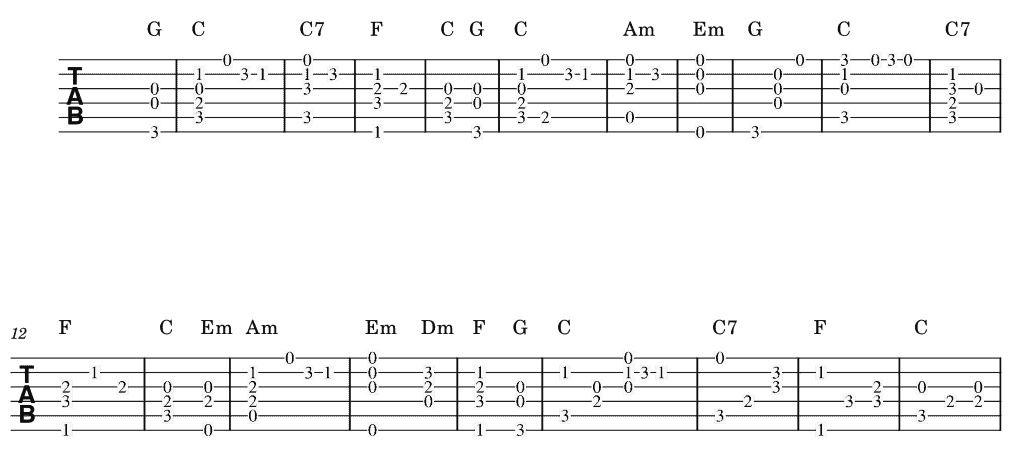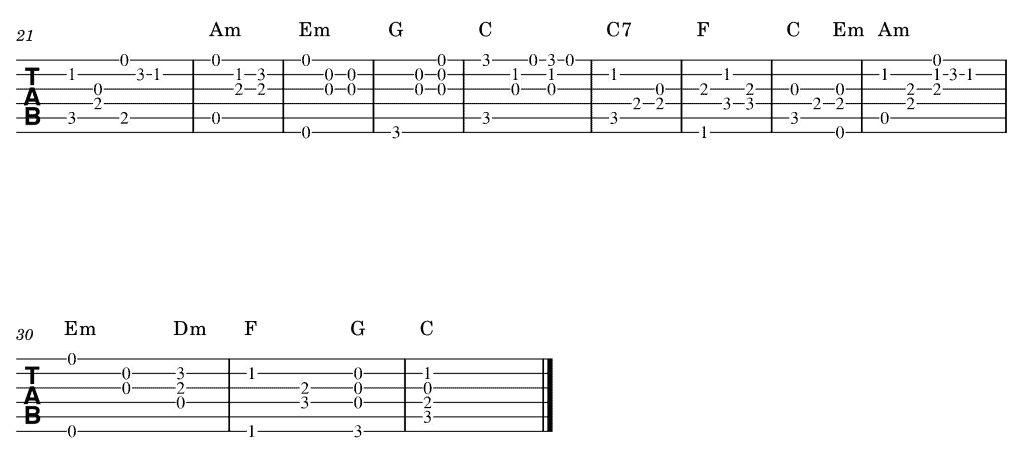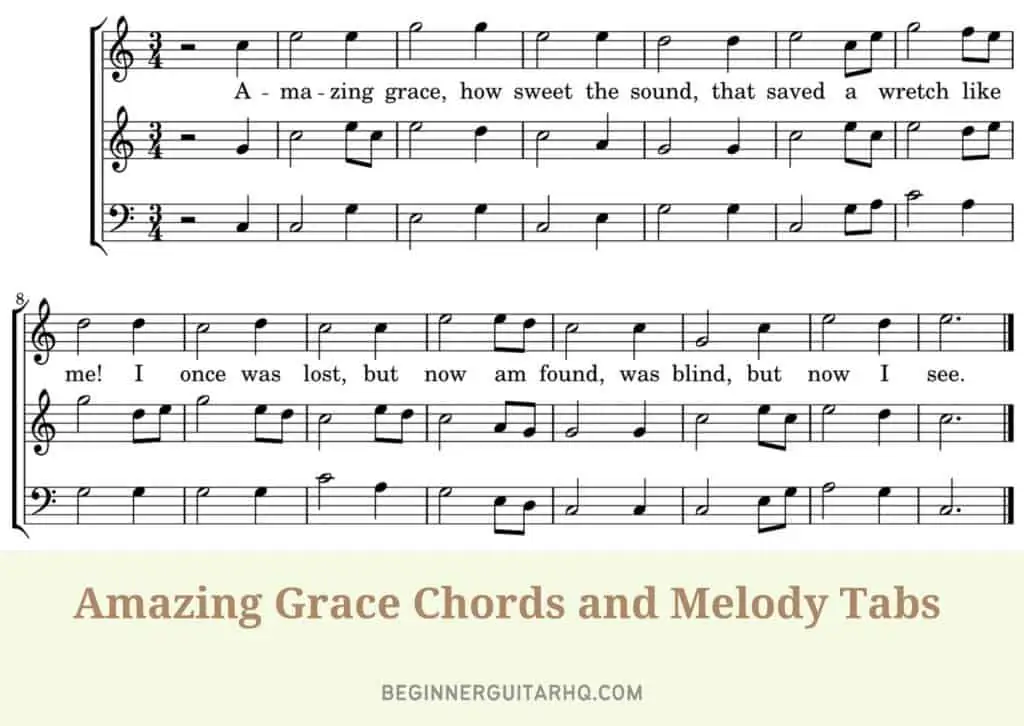Amazing Grace is one of the most popular hymns in the world. Most people will know it when they hear it, and may even know the words whether they’re Christian or not. Many musicians like this hymn because of the beautiful melody that can be simple or has as a few bells and whistles added.
While the lyrics were written in 1772, the score that we now immediately recognize as Amazing Grace was added in 1835. That’s a long time for a song to stick around and be so popular. Whether you’re just into beautiful melodies or you want to make your worship time more meaningful by using your talents, I’ll be helping you out with the Amazing Grace chords and tabs.
I’ll be sure to give you the chords in two different keys, and explain how you can transpose it to suit your vocal range if you want to sing along.
While the melody is quite simple, you can add some intricacy if you are playing without a rhythm guitarist to make it sound great. So you can look forward to tabs that you can play even if you are a beginner and a medium and a hard version, so you can play it at an intermediate and more advanced level.
The Chords to Amazing Grace
Amazing Grace in G
The Nitty Gritty
The key of G only has one sharp, the F#. This you can see by the circle of fifths. This tool is going to help you a lot with transposing. More on that later.
Here’s the scale written out in musical notation as if it’s a song:
G Major Scale- Two octaves
It’s not to say that you’ll get an F#mb5 (F sharp minor flat five) or F#o, also known as F# dim or F# diminished which would be one of the chord that fits in the G scale if you’re going by chords. It’s just something to be aware of for future reference.
The time signature is ¾. This means you’ll be playing it in the style of a waltz. The simplest way to strum a waltz is:
1 & 2 & 3 &
⬇ ⬇ ⬇ ⬆
By the arrows you can see you’ll be strumming down, down, down, with a quick up strum (in time to the music of course) at the end. If you still find this too hard, just strum down, down, down.
With practice, your strumming will improve and feel more natural. Using a metronome can help.
I’ve included the version with a G7 chord, this just adds a little bit of spice. But you don’t need to play it. You can just stay on the G. But do yourself a favor and practice G7, you’ll broaden your horizons and skill set.
You may also decide that you’d rather pick the chords, either with your fingers or your pick for a more gentle version. The last verse is very triumphant, so strumming works well there, but feel the music and play what your creativity leads you to.
Amazing Grace Chords- G
G G7 C G
Amazing grace, how sweet the sound
D
That saved a wretch like me
G G7 C G
I once was lost, but now I’m found
Em D G
Was blind but now I see
G G7 C G
‘Twas grace that taught my heart to fear
D
And grace my fears relieved
G G7 C G
How precious did that grace appear
Em D G
The hour I first believed
G G7 C G
Through many dangers, toils, and snares
D
We have already come
G G7 C G
‘Twas grace that brought us safe this far
Em D G
And grace will lead us home
G G7 C G
When we’ve been here ten thousand years
D
Bright shining as the sun
G G7 C G
We’ve no less days to sing God’s praise
Em D G
Than when we first begun
Amazing Grace in A
As you can see, this is just one whole step up. If you were playing the melody, it would be the equivalent of two frets.
A has three sharps, F#, C#, and G#. Again, this is more applicable to the melody. But you’ll see in the chord progression, you will be playing the F#m chord.
Here’s the first verse:
Amazing Grace Chords- A
A A7 D A
Amazing grace, how sweet the sound
E
That saved a wretch like me
A A7 D A
I once was lost, but now I’m found
F#m D G
Was blind but now I see
How to Transpose
Transposing or changing the key of a song is sometimes a necessary thing because of your vocal range, or perhaps because whoever is singing with you is straining to reach the notes. Sometimes it’s just for creativity, such as key changes within songs, or perhaps you just want to transpose it into a key that’s easier to play.
You can just shift up or down the fret board as necessary when you’re playing the melody or lead guitar. But in terms of chords, you would think about going up semitones or whole steps, which is easy to see if you’re playing barre chords. But it might be something that you need to wrap your mind around if you’re playing open chords.
The circle of fifths is going to be helpful here. You need to consider what chords are in that key when you play rhythm. For the most part, this is easy, even without the circle of fifths. But we can all make errors. You’ll hear it though if you have a good ear. Don’t worry, a good ear comes with regular practice and playing.
I’ve written it with a lot more info than you need for just taking the key up or down for Amazing Grace. But, these steps will help you for any song in the future and give you a better understanding beyond just shifting up or down.
For example, in G major, you get:
G, Am, Bm, C, D, Em, F#mb5
This is because the only sharp you get in G, if you stick to the rules anyway, is F#. The A chord is a minor chord because the A major triad is: A, C#, E. So because in G major, there is no F#, you need the minor triad: A, C, E.
It’s not as difficult as it sounds. That pattern that you see as I laid out the chords in G major is the same for every major key:
Major, minor, minor, major, major, minor, diminished or minor flat five.
If the whole diminished/minor flat five thing is getting to you, here’s the gist of it:
It means that both the 3rd interval and the fifth interval has been flattened. It’s really just a more complicated way of saying diminished.
In the case of F#, let’s look at the F# major scale, which has 6 sharps:
F# G# A# B C# D# E#
1 2 3 4 5 6 7
As you can see, it has many more sharps than the one sharp that G has. To construct a triad, or basic chord, you use the first, third and fifth intervals of the scale. The F# chord would be: F#, A#, C#. But to make it fit into the key of G, both the third and fifth interval need to be flattened: F#, A, C.
The result is F#mb5 or more simply, F#dim.
Using F# as an Example of Transposing a Half a Step Down
Since I have the F# scale written out, I’m quickly going to use it to demonstrate how to take the key down half a step from G major.
The chords in F# are as follows:
F#, G#m, A#m, B, C#, D#m, E#dim.
The chords you would use in Amazing Grace would be: F#, F#7, B, C#, D#m. You’ll notice that they’re simply a half a step down from the original chords which are: G, G7, C, D, Em.
This is a rather difficult key to play, so let’s take it down a whole step from G to F.
Transposing G to F
The key of F major has one flat, B.
F G A Bb C D E
So the chords in the key are:
F, Gm, Am, Bb, C, Dm, Edim
The chords you would use in Amazing Grace are: F, F7, Bb, C, Dm.
Much easier.
Transposing from G to A
Maybe you’d prefer to go a whole step up. The A major scale has three sharps and looks like this:
A, B, C#, D, E F#, G#
The chords in A major are:
A, Bm, C#m, D, E, F#m, G#dim
I already gave you the first verse of Amazing Grace in A, so it will be easy for you to see where these chords slot in. Here are the chords you would use in Amazing Grace: A, A7, D, E, F#m.
You can use these formulas for going up however many steps you want. And if you feel stuck, just check out the circle of fifths.
Amazing Grace, The Melody
Easy
In this one, I’ve included the sheet music so that you can get an idea of how the notes on the staff relate to the notes on the neck of the guitar. These are by no means the only place you can play these notes on the neck of the guitar, but it’s pretty simple if you use the G major scale shape.
Just some background, these are the note values, or how many beats they count as:
– ½ (two put together look like this ♫)
– 1
– 2
– This rest is 2 beats/counts, don’t play anything when you see a rest
.- A dot behind the note increases the note value by half its original value, in this case, it becomes 3.
Amazing Grace Tabs- Easy
Amazing Grace- Easy 1.1
Amazing Grace- Easy 1.2
Medium
This finger style version of Amazing Grace is great for if you’re playing all by yourself. It’s mostly chords with a few frills added in to make it sound beautiful. The trick is not to move your fingers unnecessarily. You’ll see that some fingers can stay put as they play chords or the ornamental bits. Do this. It’s more efficient and will make your changes quicker.
You’ll see that the chords differ a little. There are a few extra added in for more intricacy. They aren’t difficult, although some of the chord changes may be a little quicker than most beginners can play. But with practice, the chord changes will go smoothly.
Use this to play along with someone else for a rhythm and melody experience, or bust out this fingerstyle version all on its own for a beautifully gentle version.
Amazing Grace Tabs- Medium
Amazing Grace-Intermediate 1.1
Amazing Grace-Intermediate 1.2
Hard
This version will definitely take some practice, but once you have it down, it will be beautiful. The key is different for this one. It’s in E, with a few chords outside the key to spice it up. If you are playing by yourself, this finger style rendition will work really well. But the chords are there for if you want to use them instead or have a rhythm guitarist accompany you. They will also help you if you can’t figure out the phrasing.
Below is the first verse. You can either repeat it for the other verses, or you can get creative and adapt each verse to your personal vision.
Here’s a bit of an explanation about the symbols that you see above or between the numbers:
/ – slide up
\ – slide down
⁀ – Either hammer on or pull off (if the next number is higher, it’s a hammer on, if it’s lower, it’s a pull off)
ྊྊ – Vibrato
Amazing Grace Tabs- Hard


Amazing Grace-Hard
Conclusion
As you can see, there is so much you can do with this hymn. Whether you want to keep it simple, or need to keep it simple in the beginning, or you want to get to the intermediate and finally the more advanced versions, each version has its own beauty.
As mentioned throughout, you can play on your own or play with a partner/partners. With the more intricate versions, you won’t even miss the vocals.
If you struggle to play the harder versions, just remember that it takes practice. Be patient with yourself and have fun as you progress. And be consistent with your practices as well. It will really pay off, and you’ll be able to play whichever version strikes your fancy.
Enjoy playing this hymn, and may it be as meaningful as it’s beautiful.

Cheanné Lombard lives in the home of one of the new Seven World Wonders, Cape Town, South Africa. She can’t go a day without listening to or making music.
Her love of music started when her grandparents gave her a guitar. It was a smaller version of the full-sized guitars fit for her little hands. Later came a keyboard and a few years after that, a beautiful dreadnought guitar and a violin too. While she is self-taught when it comes to the guitar, she had piano lessons as a child and is now taking violin lessons as an adult.
She has been playing guitar for over 15 years and enjoys a good jam session with her husband, also an avid guitarist. In fact, the way he played those jazzy, bluesy numbers that kindled the fire in her punk rock heart. Now she explores a variety of genres and plays in the church worship group too and with whoever else is up for a jam session.






